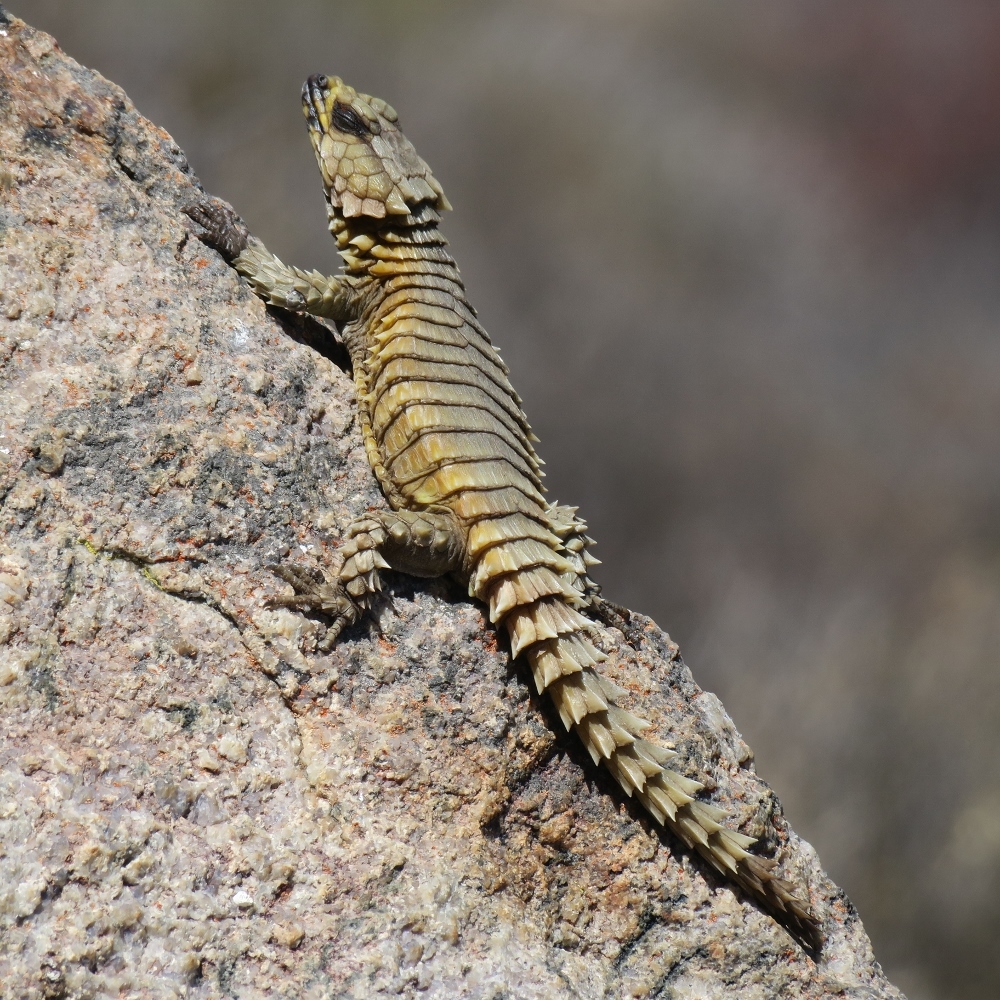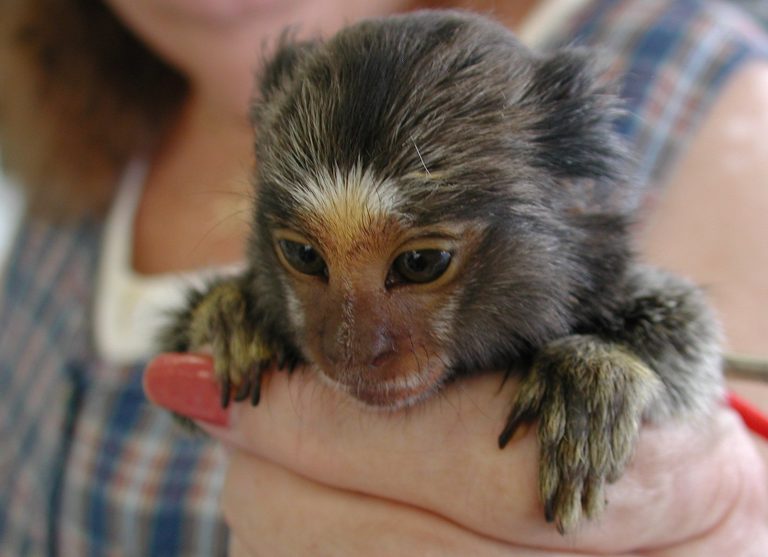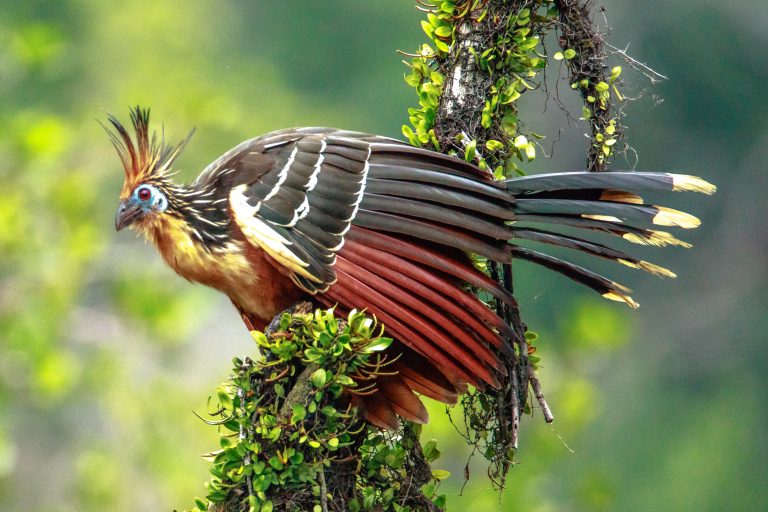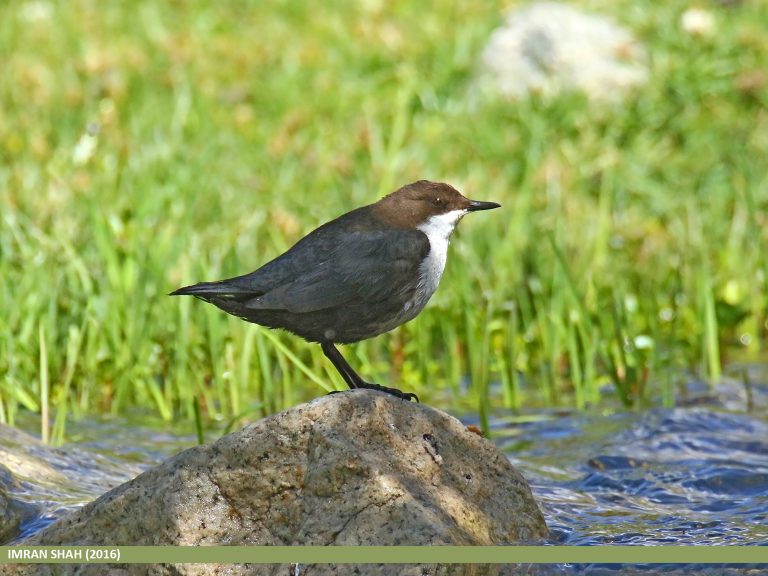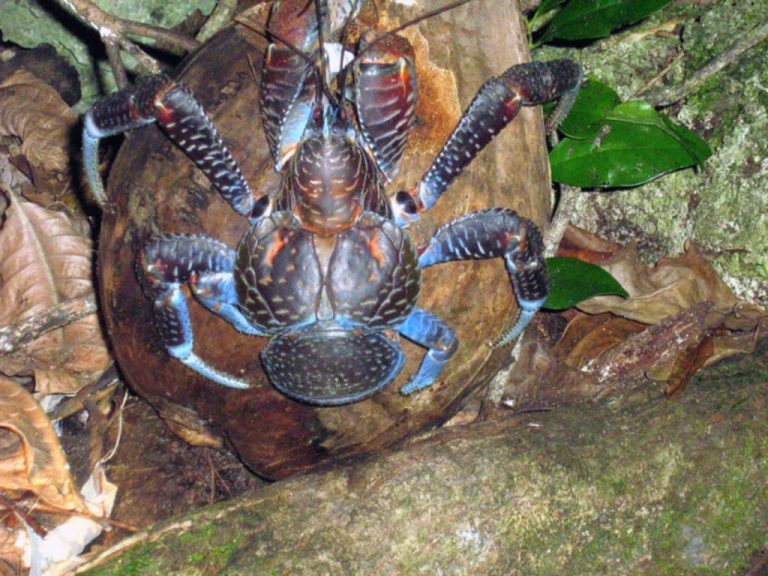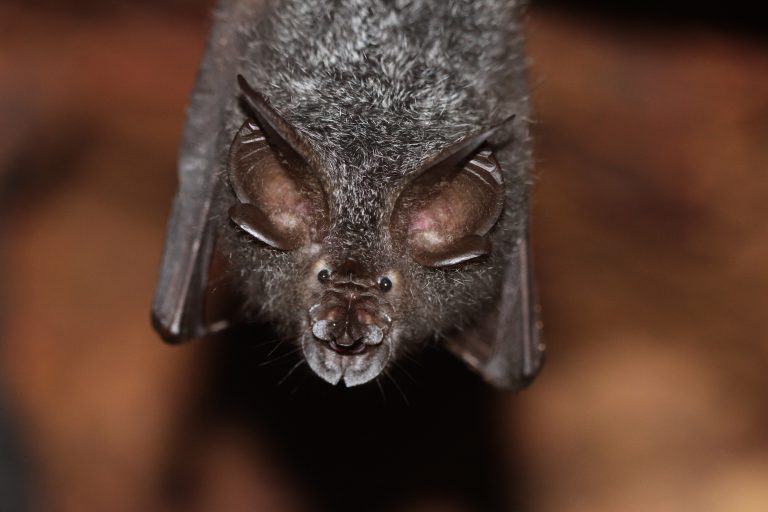Armadillo Girdled Lizard: The Tiny Dragon That Rolls Into A Ball
In the warm and arid areas along South Africa’s west coast lives a fascinating reptile.
It looks quite like a dragon and stands out from other lizards because of some behaviors that are mostly unheard of among lizards.
That’s Armadillo Girdled Lizard.
In this post, I will tell you many interesting facts about this fascinating reptile.
Armadillo Girdled Lizard
Armadillo Girdled Lizard, scientifically known as Ouroborus cataphractus
is a medium-sized lizard of the family Cordylidae.
Physical Features
Ouroborus cataphractus grows up to 4.7–6.3 inches (12–16 cm) in length.
Its stocky and flattened body is covered with thick, armer-like, spiny scales.
Its color can vary from light to dark brown, sometimes with gold highlights, and the underbelly is yellow with blackish markings.
Where do Armadillo Girdled Lizards Live?
They are endemic to desert areas along South Africa’s west coast, especially the Karoo biome.
They inhabit rocky outcrops and mountain slopes of their native range.
How Long Do Armadillo Girdled Lizards Live?
Armadillo Girdled Lizard’s lifespan in the wild is not extensively documented but it’s believed they live for 10-15 years under natural conditions.
In captivity under proper care, they can live for 20-25 years.
What Do Armadillo Girdled Lizards Eat, & What Eats Them?
They are insectivorous animals, meaning they prey on insects for food.
Their diet mainly consists of termites, and spiders cover a considerable proportion of it too.
Birds of prey, such as eagles and falcons, are the major predators that hunt Armadillo Girdled Lizards. It’s also possible that snakes and small predatory mammals prey on them too.
The Behaviour of Armadillo Girdled Lizard
Let’s explore the behavior of this exotic reptile now.
Social Behaviour & Communication
Ouroborus cataphractus stands out from most other lizards because they are social animals who live in groups.
Their groups can vary from small family units of 3-6 lizards to larger groups of up to 60 individuals.
A group typically consists of one dominant male, several females, and juveniles.
Males are territorial. Dominant males defend their territories that have multiple females, and females and juveniles move freely between groups. This intergroup movement of females and juveniles facilitates gene flow.
Within a group, the members use visual signals such as head bobbing, tail wagging, and tongue flicking to establish dominance, warn intruders, and coordinate interaction.
Defensive Behaviour
When an Armadillo Girdled Lizard feels threatened it curls up into a ball and bites its tail.
This allows it to protect its vulnerable underbelly with the spiny scales of its back.
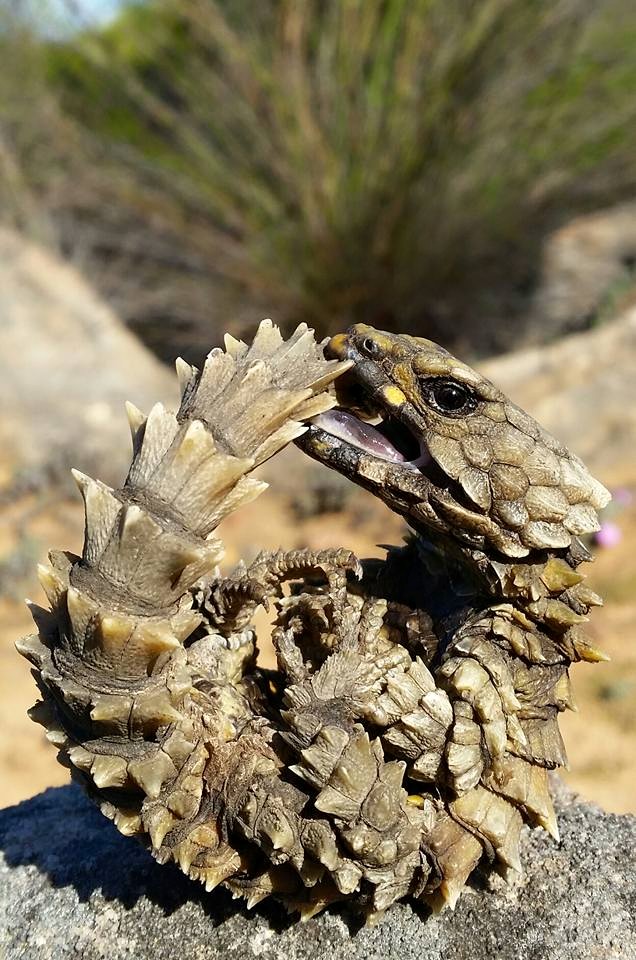
Own work
Activity & Foraging
Armadillo Girdled Lizards are diurnal animals, meaning they are active mostly during daytime.
They spend a lot of time basking on rocks.
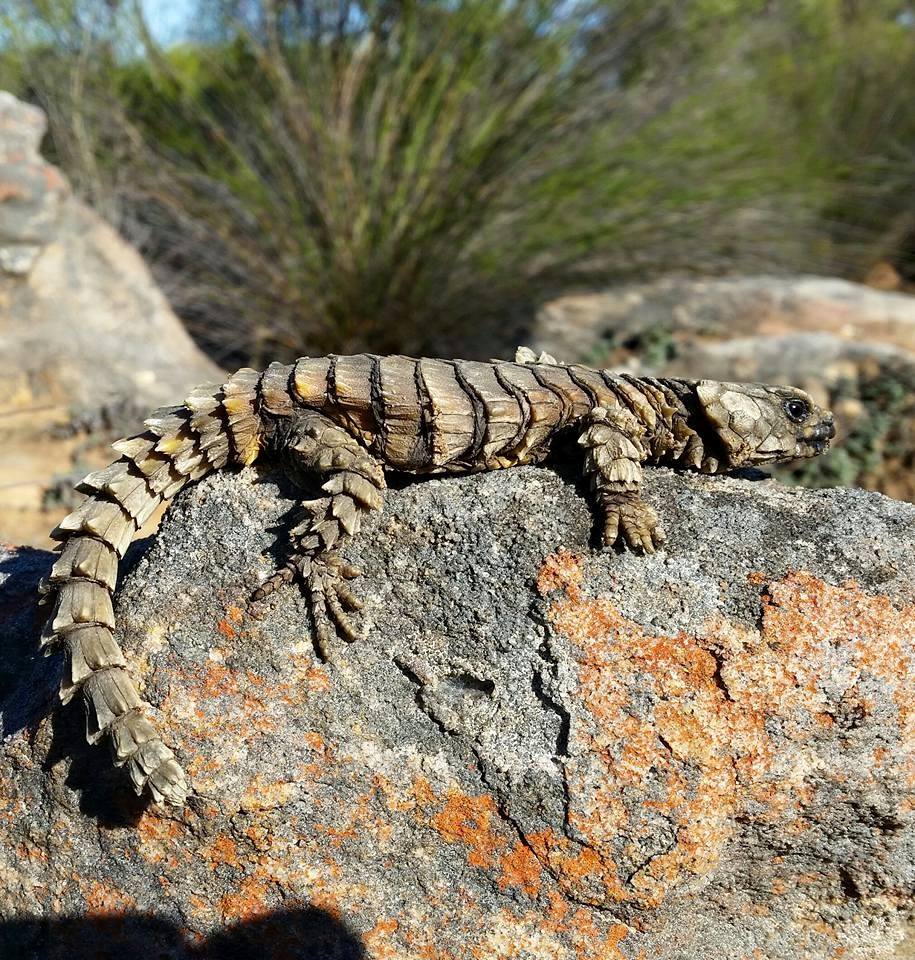
Own work
Their diet mainly consists of termites and other insects and spiders. Sometimes they supplement their insectivorous diet with plant material.
How Do Armadillo Girdled Lizards Reproduce?
Let’s look at the reproductive behavior of Ouroborus cataphractus now.
Sexual Maturity
They become sexually mature when they are around 2-3 years old. Sexually mature males are typically larger and more territorial.
Mating behavior
They are polygynandrous animals, meaning both males and females mate with multiple partners within the mating season.
The territorial males mate with the females within their territories and females move between groups, mating with multiple males.
Breeding Season & Breeding Frequency
In their native habitats, mating typically occurs in early spring, around September to October.
Males produce sperm in cycles. The sperm production peaks in spring (prenuptial cycle) or late summer (postnuptial cycle).
Females usually give birth once a year, but may skip a year, especially if they are caring for their young or the environmental conditions are too harsh.
Ovoviviparous Reproduction
This species is ovoviviparous, meaning that the females don’t lay eggs but give birth to live young. The eggs develop and hatch inside the mother’s body.
The gestation period is 5-8 months, depending on the environmental conditions.
Offspring & Parental Care
Females usually give birth to one or two live young. When two are born, the second one is often smaller and weaker.
The newborns are miniature versions of the adult lizards.
Another remarkable thing about Armadillo Girdled Lizards is that the females feed and care for their offspring, something unusual among lizards.
The young stay with their mother or the social group for a short time before dispersing.
The Importance of Armadillo Girdled Lizard
Armadillo Girdled Lizard is important for the balance and longevity of its habitat ecosystems.
It holds significant scientific and educational value too.
Ecological Role
Being a key insectivore in its natural habitat, Armadillo Girdled Lizard helps control the populations of termites and other small invertebrates.
That way, it contributes to the balance and health of its habitat ecosystems.
On the other hand, it supports native birds of prey and possibly small carnivorous mammals by being prey, contributing to the local food webs.
Even though it has been formally designated an indicator species, it can still be a useful indicator of the ecosystems it occupies, as declines in their populations can hint at broader environmental shifts such as habitat degradation and climate change.
Research Value
Ouroborus cataphractus has the largest known genome (collection of DNA) of all scaled reptiles.
So it’s an important species in research about evolution.
Its defensive behavior of curling up into a ball provides insights into evolutionary adaptations in harsh environments.
Armadillo Girdled Lizards as Pets
The scaly, dragon-like appearance and the peculiar behaviors of Ouroborus cataphractus have gained it some popularity as an exotic pet.
But how ethical is it to keep them as pets? What are the Legal implications? What are the care requirements?
Let’s find out:
Ethical Considerations
Capturing Armadillo Girdled Lizards from the wild for pet trade disrupts natural populations and threatens their survival as a species. So think about that before getting one as a pet.
If you are seriously considering having one as a pet, seek a captive-bred one from a reputable breeder so you don’t contribute to the illegal pet trade.
Legal Implications
Armadillo Girdled Lizard is protected in its native South Africa.
International trade of this animal is regulated by CITES Appendix II due to potential population declines from over-collection and habitat loss.
In many countries and regions, owing, buying, or selling them a permit is prohibited.
In the United States, regulations are different from state to state, with some states requiring permits while others completely prohibiting ownership.
Care Requirements
To keep an Armadillo Girdled Lizard as a pet, an enclosure that mimics the conditions of its natural habitat is needed.
It must be spacious and secure and have plenty of rocks and hiding places and a warm, dry condition.
A heat source of around 95–105°F/35–40°C must be provided for basking, along with UVB lighting.
Only one male should be housed per enclosure to prevent aggression.
A diet consisting mainly of live insects such as crickets, roaches, and mealworms must be provided.
Wild-caught specimens can carry parasites and suffer from stress-induced ailments, so a veterinary checkup is a must.
Conservation Status
Now let’s see how the Armadillo Girdled Lizard is faring in the wild.
IUCN Red List Category
Armadillo Girdled Lizard is considered near-threatened on the IUCN Red List.
Legal Protection
In the past, illegal collection for the pet trade had been a significant threat, but enforcement of laws and regulations against it has reduced the threat in recent years.
It’s protected under South African law and international trade is regulated by CITES Appendix II.
Potential Threat from Habitat Loss & Climate Change
Habitat Loss and degradation caused by the spreading of invasive alien plants and poor management of fires can hurt their populations.
Rainfall fluctuations due to climate change affect termite populations, and since termites are Armadillo Girdled Lizards’ main food source, it poses a potential threat to their populations, too.
All in A Nutshell
Armadillo Girdled Lizard is a remarkable species from the west coast of South Africa, standing out with its scaly armor, peculiar defensive behavior, social lifestyle, and viviparous reproduction.
It plays a significant ecological role in controlling insect populations of its native habitats and supporting local food webs.
It’s an important subject in the study of evolution.
Though popular as pets, there are legal and ethical considerations regarding keeping them as pets.
Designated near-threatened on the IUCN Red List, it used to be threatened due to over-collection for pet trade but is currently protected by local and international laws.
Habitat loss and climate change are the other things posing potential threats to this species.

